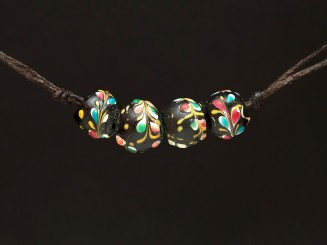4 Venetian trade beads (fiorà)
Mali
Lenght: 44 mm
Weight: 10 gr
Diameter: 14
Units: 4
A set of four joyful lamp work Venetian fiorà trade beads from the first half of the XIXth century. Their name comes from their characteristic floral or flower decoration that in a captivating array of colors and motifs is distributed on the main body of the bead which, in this particular case, is of a nice opaque black color.
Approximate dimensions (larger bead): 12mm x Ø14mm.
Also referred to as decorated fancy beads, fiorate or fiorà, these Venetian lamp work glass trade beads are amongst the most attractive we may find. Their main feature is their flamboyant and joyful floral or flower decoration using a rich variety of colors and patterns: feather, bow tie, bouquet, dots, spiral (here we have to mention the well-known Lewis & Clark beads named after the explorers who first traded them with the tribes they found on their expedition from the East to the West coast of the United States in the early 1800s), linear, filigree, etc. They were mainly produced as from the first half of the 19th century. They are usually round or oval shaped.
We use the term trade beads to refer to the European made glass beads that were used by the European merchants and explorers in the trade in Africa as from the 15th century and continued during their colonial expansion.The history of trade beads in Africa takes us then to the 15th century and the arrival of the European, mainly the Portuguese, to the coasts of West Africa. The European discovered quite soon how much the people they met there fancied beads and saw they an opportunity for trade. Amongst the beads that captivated the African people most were glass beads since the techniques for their making had not yet been developed locally. The locals fell for the precious and colorful glass beads such as Venetian millefiori or chevron beads that the European traders had on offer and bartered them for commodities such as precious woods, ivory, gold and even used, ignominiously, in the slave trade. The increasing demand in Africa of European made glass beads continued quite until the first half of the 20th century and it had a boosting effect in the production in cities such as Venice which glass beads became very popular and coveted.




